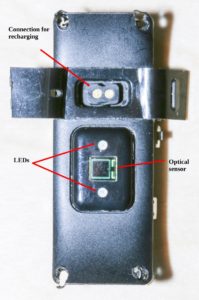It’s said that nearly 80% of the battery power in smartwatches goes to running the heart-rate monitor. But a new generation of photodiodes able to function as heart-rate sensors consumes five times less energy than the devices now found in smartwatches.
The new photodiodes were developed by a Swiss startup called ActLight in conjunction with Ecole Polytechnique Federale de Lausanne. Dubbed a “dynamic photodiode (DPD),” the ActLight device can consume less power than ordinary photodiodes because it doesn’t operate continuously. And when turned on, it operates from bias voltages of only around one volt. In contrast, ordinary photodiodes tend to be operated from constant biases of between 5 and 12 V as a way of boosting photodiode response time.

The heartbeat sensor in a fitness watch generally consists of both an optical sensor chip and the two infrared LEDs. In normal use the optical sensor detects light from the LEDs that reflects from the wear’s skin. Heartbeat detection is via a technique called pulse oximetry. This measurement method takes advantage of the fact that oxygenated and de-oxygenated hemoglobin have different optical properties. With every heartbeat, there is a spike in arterial oxygenated blood which the optical sensor detects as a change in the skin’s absorbance or reflectance of LED light.
Put another way, the optical sensor measures the amount of LED light reflecting from the blood under the wearer’s skin. The reflectance is a bit different during a heartbeat, and the sensor will detect this periodic signal from which the heart rate is extracted, at least in theory.


Instead of using a constant dc bias as with ordinary photodiodes, the DPD operates at pulsed voltages. It is the triggering time of its output current that serves as a measurement of sensed light. The DPD also works from voltages of around one volt. The DPD is built with standard low-cost CMOS technology so it can be integrated with other CMOS circuits.
The pulsed nature of DPD operation results in a small reduction in smartwatch energy consumption with every heartbeat. But with more than 50,000 heartbeats measured per day there is a considerable energy savings, ActLight says.
The new sensors “are less expensive to produce because they do not require as much silicon for the same level of manufacturing,” said Sergei Okhonin, ActLight CEO. Numerous other applications are also being targeted, such as gesture control for video gamers.



Leave a Reply